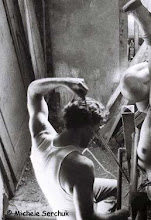 Switching from photography, in whose bright precincts I have spent most of my slavish devotion to the representative arts, I
Switching from photography, in whose bright precincts I have spent most of my slavish devotion to the representative arts, I  take you now to the rarefied world of my fellow subversive and friend Sophi, aka Carolyn Weltman, multiple-award-winning figurative artist, flyweight dominatrix, faerie Queen and Her Majesty's Registrar of Secrets-Hiding-in-Plain-Sight.
take you now to the rarefied world of my fellow subversive and friend Sophi, aka Carolyn Weltman, multiple-award-winning figurative artist, flyweight dominatrix, faerie Queen and Her Majesty's Registrar of Secrets-Hiding-in-Plain-Sight.Our kinky compatriot Jane Duvall inadvertently introduced us by posting a gallery of Sophi's work on her site, into which I'd fallen from a link at my future business partner's site where Jane was guest-bottoming.
 I was immediately smitten with the toppish impatience revealed in Sophi's drawings and her obvious affinity and intuitive feel for the human form in bondage. I say intuitive because it was immediately apparent that the ropework in her pieces were either purely imaginative constructs or renderings of restraint limited in their potential efficacy only by... well, for starters, physics (e.g., certain troublesome aspects of gravity - as much a problem in art-making as in bondage rigging, apparently).
I was immediately smitten with the toppish impatience revealed in Sophi's drawings and her obvious affinity and intuitive feel for the human form in bondage. I say intuitive because it was immediately apparent that the ropework in her pieces were either purely imaginative constructs or renderings of restraint limited in their potential efficacy only by... well, for starters, physics (e.g., certain troublesome aspects of gravity - as much a problem in art-making as in bondage rigging, apparently).But apart from such pissant and geekish exceptions these pieces were a revelation. It was clear that Sophi got it, and this at a time when I was having difficulty describing "it" even to myself. I inquired to the proffered email and received a polite reply with the indication that the artist had some connection to New York City...
Within a few weeks I would be accompanying Delano and other fellow rope freaks at the first BondCon in Queens. By then Sophi and I had developed a dialogue and she had allowed that she would be on West Broadway in Soho presenting her wares on dates when I would likely be showing out-of-towners a bit of my home turf. I found her holding court under an umbrella and surrounded by a bottomless wealth of erotica, all of her own devising. We were chums as of the first embrace.

Among the first of my entreaties to her (for I was at once extraordinarily admiring, turned on, inspired, but largely mystified by her work) concerned her faces, or the lack of them. While her figures were delightfully amplified in irregularity of torso, extremity and mane, not a one of them had but the vaguest hint of physiognomy. In my journal entry for that night I quoted Sophi as asking me "Well, dear Mac, who would you have them be?" Who, indeed. My rumination on that point would end up informing much.

Over the years I have modeled for Sophi on numerous occasions, elaborating on my long
 experience sitting for life drawing classes. The results have varied from merely excellent to world class. One of our collaborations (a drawing of an exercise Fakir Musafar reminds us is traditionally referred to as a lingam pendulum, right) hangs now in the permanent collection of the Kinsey Institute. In the leading rôle is a glass block that still haunts Sophi's studio and still makes a good story when visitors call.
experience sitting for life drawing classes. The results have varied from merely excellent to world class. One of our collaborations (a drawing of an exercise Fakir Musafar reminds us is traditionally referred to as a lingam pendulum, right) hangs now in the permanent collection of the Kinsey Institute. In the leading rôle is a glass block that still haunts Sophi's studio and still makes a good story when visitors call.Fin and I have modeled together as well, most recently logging 25 images over many sessions for Sophi's contribution to the soon-to-be-released Mammoth Book of the Kama Sutra. As a fond interpreter of sadistic self-expression I can vouchsafe that most severe erotic torture is wholly inadequate to more than even a few short minutes holding Utthita-uttana-bandha so it can be drawn. Still, by all means, do try this (and everything else you see in this very well-done book) at home - just keep moving.
With as many years as I've been back in NYC I've had the faith and confidence of this most dear friend to participate in her art and way of world-making. The record is large - much more than could ever be done justice here. I'll be posting more of Sophi and about our connection in the near future.
























